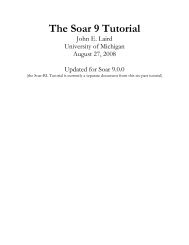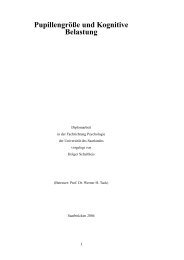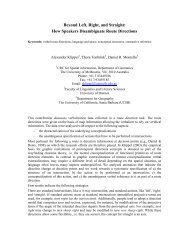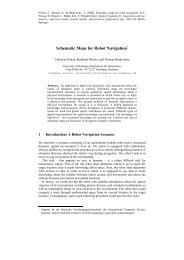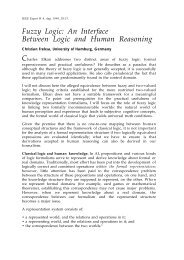SparQ: A Toolbox for Qualitative Spatial Representation and ...
SparQ: A Toolbox for Qualitative Spatial Representation and ...
SparQ: A Toolbox for Qualitative Spatial Representation and ...
You also want an ePaper? Increase the reach of your titles
YUMPU automatically turns print PDFs into web optimized ePapers that Google loves.
2.3 Constraint reasoning with spatial calculi<br />
<strong>Spatial</strong> calculi are often used to <strong>for</strong>mulate constraints about the spatial configurations<br />
of a set of objects from the domain of the calculus as a constraint<br />
satisfaction problem (CSP): Such a spatial constraint satisfaction problem then<br />
consists of a set of variables X1, ..., Xn (one <strong>for</strong> each spatial object) <strong>and</strong> a set of<br />
constraints C1, ..., Cm (relations from the calculus). Each variable Xi can take<br />
values from the domain of the utilized calculus. CSPs are often visualized as<br />
constraint networks which are graphs with nodes corresponding to the variables<br />
<strong>and</strong> arcs corresponding to constraints. A CSP is consistent, if an assignment<br />
<strong>for</strong> all variables to values of the domain can be found, that satisfies all the constraints.<br />
<strong>Spatial</strong> CSPs usually have infinite domains <strong>and</strong> thus backtracking over<br />
the domains can not be used to determine global consistency.<br />
Besides global consistency, weaker <strong>for</strong>ms of consistency called local consistencies<br />
are of interest in QSR. On the one h<strong>and</strong>, they can be employed as a <strong>for</strong>ward<br />
checking technique reducing the CSP to a smaller equivalent one (one that has<br />
the same set of solutions). Furthermore, in some cases they can be proven to<br />
be not only necessary but also sufficient <strong>for</strong> global consistency <strong>for</strong> the set R of<br />
relations of a given calculus. If this is only the case <strong>for</strong> a certain subset S of R<br />
<strong>and</strong> this subset exhaustively splits R (which means that every relation from R<br />
can be expressed as a disjunction of relations from S), this at least allows to <strong>for</strong>mulate<br />
a backtracking algorithm to determine global consistency by recursively<br />
splitting the constraints <strong>and</strong> using the local consistency as a decision procedure<br />
<strong>for</strong> the resulting CSPs with constraints from S [17].<br />
One important <strong>for</strong>m of local consistency is path-consistency which (in binary<br />
CSPs) means that <strong>for</strong> every triple of variables each consistent evaluation of the<br />
first two variables can be extended to the third variable in such a way that all<br />
constraints are satisfied. Path-consistency can be en<strong>for</strong>ced syntactically based on<br />
the composition operation (<strong>for</strong> instance with the algorithm by van Beek [18]) in<br />
O(n 3 ) time where n is the number of variables. However, this syntactic procedure<br />
does not necessarily yield the correct result with respect to path-consistency as<br />
defined above. Whether this is the case or not needs be investigated <strong>for</strong> each<br />
individual calculus.<br />
2.4 Supported calculi<br />
The calculi currently included in <strong>SparQ</strong> are the FlipFlop Calculus (FFC) [8]<br />
with the LR refinement described in [19], the Single Cross Calculus (SCC) <strong>and</strong><br />
Double Cross Calculus (DCC) [6], the coarse-grained variant of the Dipole Relation<br />
Algebra (DRAc) [11,12], the Oriented Point Relation Algebra OPRAm<br />
[9], as well as RCC-5 <strong>and</strong> RCC-8 5 [3]. An overview is given in Table 1 where<br />
the calculi are classified according to their arity (binary, ternary), their domain<br />
(points, oriented points, line segments, regions), <strong>and</strong> the aspect of space modeled<br />
(orientation, distance, mereotopology). As can be seen, mainly calculi <strong>for</strong><br />
5 Currently only the relational specification is available <strong>for</strong> RCC, but no qualifier.



